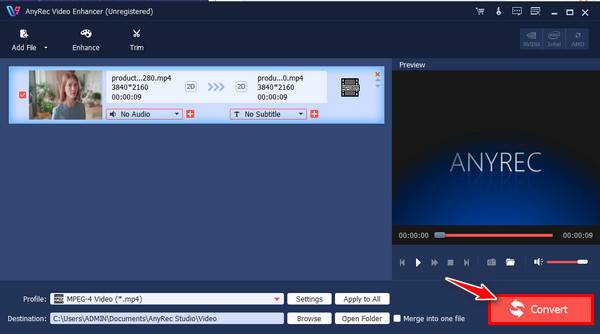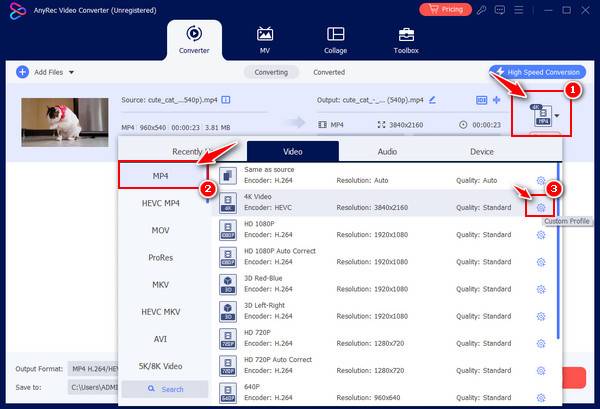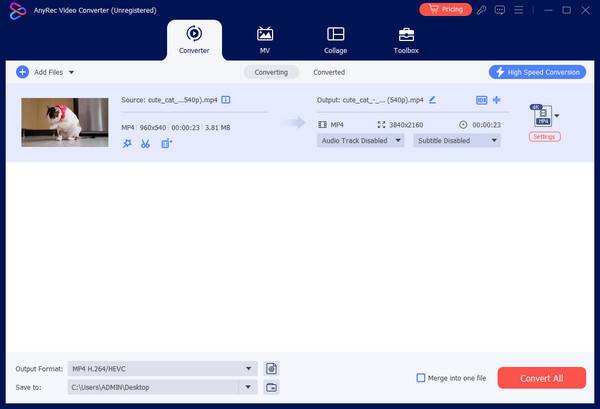Fix Pixelated or Grainy Videos with 4 Working Ways
Imagine this: actors in your most loved movie were in polygon-like shapes or grainy, pixelated to be exact. Would you have a pleasant viewing experience, then? Surely not! So, how to fix pixelated videos to watch the content with high quality. Although it’s not easy for you to enhance the video quality, this post is ready to give you four ways to remove grain and fix pixelated videos with bonus tips. Check them out today!
Guide List
Why Will You Get Pixelated/Grainy Videos? 4 Efficient Ways to Fix Pixelated Videos on Windows/Mac Bonus Tip to Avoid Taking Pixelated/Grainy Videos FAQsWhy Will You Get Pixelated/Grainy Videos?
Before getting closer to the ways to fix grainy video, you should at least have an idea of what the factors are that lead your video to get pixelated. Usually, pixelation happens because the video file data is compressed, which makes the file smaller and minimizes storage usage; this could have a negative effect on the video quality.
Besides that, here are some of the likely reasons why you get pixelated video:
- The video is recorded in a low-light environment.
- Camera settings are set in improper combinations.
- Video encoding issue during the exporting process.
- You used a camera with small sensors that struggled to record details.
- Videos are set to be recorded at low aperture settings.
- The video file is severely corrupted without your knowledge.
Regardless of why you get pixelated videos, it’s vital to significantly improve it immediately to enjoy watching your favorite movie. Find out below how to fix pixelated videos in the four best ways!
4 Efficient Ways to Fix Pixelated Videos on Windows/Mac
As mentioned earlier, fixing pixelated video may not be as effortless as you thought, but one thing is sure this post will give you the right tricks to apply to your pixelated video. So, sit back and relax as you’re being guided by the following four effective ways how to make videos not blurry.
Method 1: Increase the Video Resolution with AI
For some time now, you may have struggled with finding the best way to fix grainy video, but not until today, as you will learn about AnyRec Video Enhancer. There are a lot of ways how to get your video unblurred or make it high-quality, and this enhancer software has four AI solutions for enhancing your video. One of those four is the upscaling resolution that works in just a click! Using it, you can enhance resolution from 720p to 1080p, even 4K up to 8K, without needing others' help or specialized skills. As you use it, you’ll explore various editing functionalities that will make your videos shine more than others.

Upscale video resolution for up to 4K/8K in one click without losing details.
Inside, there is a built-in video editor to make your video look much better.
Able to optimize effects, remove noises, lessen video shakiness, and more.
Check your enhanced video before exporting it to your chosen format.
100% Secure
100% Secure
Step 1.To fix grainy video, launch the AnyRec Video Enhancer on your Windows/Mac desktop. Next, click the "Add File" button to open your pixelated video.
Step 2.Once loaded, go to the "Enhance" button above to proceed. On the Enhance window, click the "Upscale Resolution" checkbox on the right panel.

Step 3.Click the "Apply" button to keep the upscaling you apply. In the main interface, you can determine the format, resolution, bitrate, frame rate, and so on with the "Settings" button.

Step 4.Later, go for the "Browse" button to specify the file path of your video, then click the "Convert" button on the corner to start fixing the pixelated videos and downloading them.

100% Secure
100% Secure
Method 2: Use After Effects to Edit and Unpixel Video
Aside from enhancing the video resolution to fix grainy video, one way to remove pixels is through Adobe After Effects. It comes with a built-in Remove Grain effect, which enables you to eliminate the pixelation from your videos that is caused by high ISO or low light during recording.
Step 1.Get the "After Effects" plugins from Adobe. After that, launch it, import your pixelated video, and drag it to the editing timeline.
Step 2.Hover your cursor in the "Effects & Preset" panel and search for the "Remove Grain" effect. Hold down the effect, then drag it into the editing area.

Step 3.Afterward, head to the "Noise Reduction Settings" and adjust its values to make your video more realistic. Then, switch the "Viewing Mode" from "Preview" to "Final Output".

Method 3: Quickly Fix Pixelated Video with VLC
VLC Media Player works beyond just being a media player installed on every computer. The player can help you learn how to make a video less pixelated. Still, there’s a catch: VLC only fixes videos in AVI format, so you would have to convert or rename your file, and it won’t let you export the video since the playback is only available in VLC.
Anyway, here’s how to fix pixelated videos with this video quality enhancer tool:
Step 1.Once you’ve launched VLC, go to the "Tools" tab above, select "Preferences", and enter the "Input/Codecs" section.

Step 2.Move your cursor to the "Damaged or incomplete AVI file" drop-down menu and select "Always Fix". Click the "Save" button to put changes at work.

Step 3.Going back to the main screen, click the "Media" tab and choose "Open File" to open your video file, and see if you can watch it.
Method 4: Re-encode the Pixelated Videos
Most of the time, the problem is incompatible codecs with the media player, which is why you’re having pixelated videos. Therefore, to fix grainy video, make use of a converter, like AnyRec Video Converter, that can help you alter your video file to a supported format. Using this amazing program, you are welcome to choose one from over 1000 formats with customizable profile settings, like MP4, MOV, AVI, MKV, M4V, etc. There is no steep learning curve throughout the quick process, and the video quality will not be affected, ensuring you’ll get a high-quality conversion.
Step 1.Upon opening the AnyRec Video Converter, get started by adding your pixelated video into it by clicking the "Add File" button. Then, click the "Format" menu button on the right side.

Step 2.Once inside the "Format" window, under the "Video" section, select your desired format, "MP4", with a customized profile. If you want to make changes, click the "Custom Profile" button, and adjust the encoder, frame rate, quality, etc.

Step 3.When complete fixing the pixelated videos, set your video's filename and path and click the "Convert All" button. Play your video now and see if it is cleared.

100% Secure
100% Secure
Bonus Tip to Avoid Taking Pixelated/Grainy Videos
Regardless of whether you’re excited to apply the said ways on how to fix pixelated videos, isn’t it nice if you do not have to experience pixelated videos? Consider seeing the following tips to avoid having grainy videos.
Have an ideal lighting condition. Record video with natural daylight and try not to shoot in low-light environments. Meanwhile, if you will be recording at night, use artificial lighting that is perfect for shooting videos.
Use a wide aperture. A wide aperture allows lighter to get in and focus on near things, letting you produce more bright footage.
Use proper camera settings. Make sure to record your video in high resolution to prevent having a grainy effect after recording.
Make use of lower ISO settings. Though having a higher value of ISO leads to a brighter video, the grains, and noises will be in there, too. Thus, consider lessening the ISO, like 100-800, to prevent greains.
FAQs
-
How to fix pixelated videos when I play them on Windows Media Player?
If WMP gives you pixelated videos, you can adjust the hardware acceleration settings, update your drivers, or install a codec pack. See if one of them fixes the issue.
-
Why is my 1080p look so pixelated?
Commonly, this issue happens because of heavy compression at low bitrate, undersized encoding, oversharpening, and upscaling from SD cards.
-
Can I remove pixelated videos online?
Yes. You can fix grainy videos online; however, most web-based tools will leave a watermark. But some tools worth trying are VEED.IO, Clideo, Flixier, Media.io, etc.
-
Is it possible to use iMovie to fix grainy video?
Yes. To do so, open your pixelated video, then drag it into the editing timeline. Click the video clip, and choose Adjust to increase the resolution and video sharpness and lessen the noise to get your desired result.
-
How to use VLC to remove grain from video?
Launch the player, and open your pixelated video to it. Afterward, head to the "Tools" tab and select "Effects and Filters"; otherwise, press the Ctrl + E keys. Next, click on Video Effects, then apply a sharpened filter to minimize the pixelation from your video.
Conclusion
That’s all for today! This post has discussed four ways how to fix pixelated videos. You can quickly try all of them, and see which solutions fix your issue in no time. However, suppose you don’t want to waste time resolving the pixelated video issue. At that point, it’s suggested to go straight to the AnyRec Video Enhancer tool that upscales video resolution and apply three other enhancing AI solutions in clicks! To get to know more about it, download the enhancer software today!
100% Secure
100% Secure
